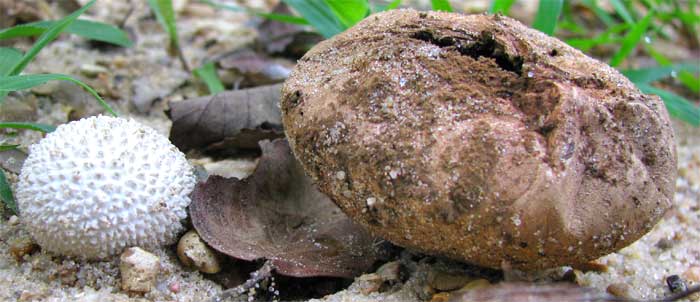Excerpts from Jim Conrad's
Naturalist Newsletter

from the August 4, 2008 Newsletter, issued from the forest near Natchez, Mississippi; elevation ~400ft (120m), ~N31.47°, ~W91.29°:
WHITE LYCOPERDON PUFFBALLS
Not many mushrooms are out nowadays. They'll come later, with fall rains. However, one fungus you can indeed find here and there is the White Lycoperdon, LYCOPERDON CANDIDUM, one of the puffballs. That's what we have above.
The white puffball in the picture is about the size of a golf ball. The potato-like object at the right is an old fruiting body, after most of its dark, dustlike spores have escaped through the natural opening at the top. The white puffball on the left will grow a little more, but not much, as its white, marshmallow-textured flesh dries, darkens and forms a mass of spores.
As the spores near maturity the white, soft-spiny covering visible in the picture will crack into irregular plates and fall off, leaving a smooth, dark brown, fruiting body that eventually will develop a hole in its top for spores to escape from. At first the mature fruiting body will be only slightly larger than the white stage. However, after passing through a whole year of weather it'll swell up like a discarded phonebook after a year in the rain.
White Lycoperdons are widely distributed, fairly common, and edible, though I find them rather bland. If you sauté them in butter with black pepper, however, they're tasty, as is almost anything sautéed in butter with black pepper. They like to grow in sandy soil, which is exactly where I found the ones in the picture, along the gravel road through Homochitto National Forest.
I've told you before what the genus name Lycoperdon means, but it's worth repeating for new subscribers. In classical Greek, lyco meant "wolf," while perdon meant "to break wind." So these are "wolf- farts."
That shrub's leaves were similar to those of Black Locust but its dark, slender spikes weren't like anything commonly seen around here. Though the main flowering time already had past, a couple of shrubs still bore flowering spikes, a close-up shown below: